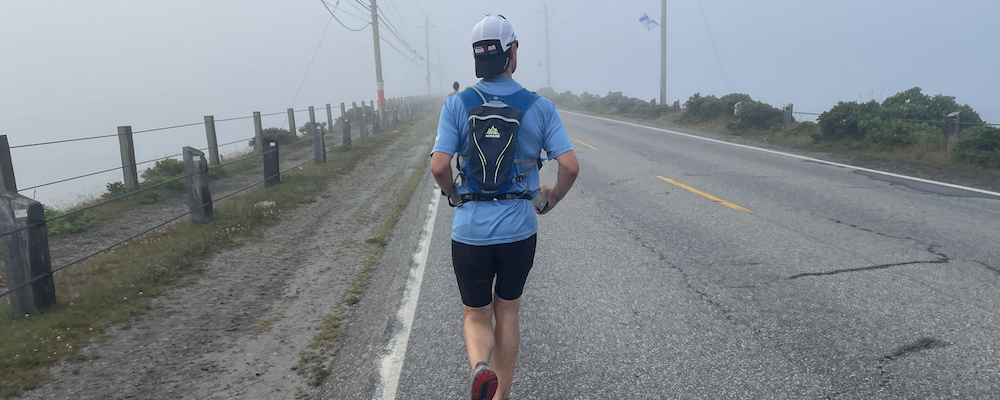Overall rating: 8/10 see why at the end of the report | comparison of all my races
This year has been busy already, in terms of sports events – it started with a 10km trail run in January, followed by a full Marathon through snow and ice at -15ºC in February. In March, I participated in North America’s oldest road race, ‘Around The Bay’ in Hamilton (30km), just a couple weeks before I finally beat my 90 minutes half marathon goal at a race in Cornwall. In May, I almost qualified for Boston during Ottawa Race Weekend, by running a full marathon in 3h12m. Now it’s July, and another event was planned: The ‘Sea Me Run’ marathon in Nova Scotia: 42 kilometers along the beautiful Atlantic coast around Sherose Island.
Sickness during peak training
I was looking forward to a scenic marathon, without having any particular race goals other than enjoying the run, the scenery, and the lovely atmosphere of a locally organized event in an area I’ve never visited before. All this almost wasn’t going to happen, though; only four weeks before the race I got sick, not even knowing what it was. Involuntarily, I got to know the Canadian health system and struggled finding my way around it… from finding doctors, getting appointments, and receiving useful advice. It turned out that I caught some digestive parasite that made my training almost impossible and needed treatment with meds over a couple of weeks. I tried getting in some runs during that time, but I always felt terrible even after only 10 kilometers. Usually, a couple weeks prior to a marathon, you’re supposed to do long runs and increase your running volume quite a bit – meanwhile, I basically decreased my training to zero, hoping that I somehow would still be able to at least cross the starting line in Nova Scotia.
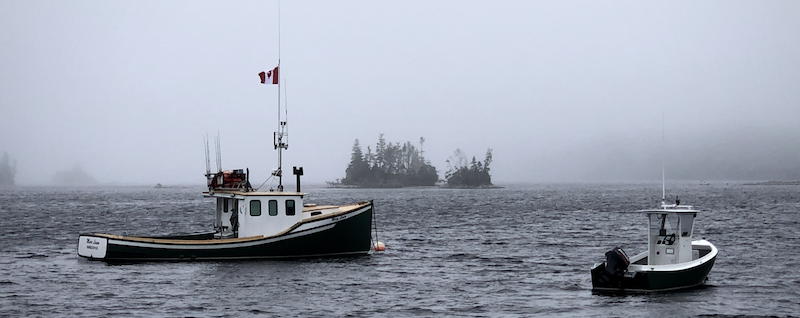
Pre-race: shake-out and carbo-load
It was never an option for me to just defer the race. We were going on vacation to Nova Scotia anyways, the race fees had been paid and weren’t refundable, and I was confident that somehow, I’d be able to complete the distance, even if I’d had to walk big portions of it. This was not my first run of that distance, and experience usually pays off well in this sport. Also, the meds seemed to be working and I kept getting better; only training wasn’t possible yet.
We arrived in Halifax a couple days before the event, and my 6km shake-out run the day prior actually felt quite good! I was still nervous about the full distance but looking forward to at least being part of a vibrant starting field of runners.
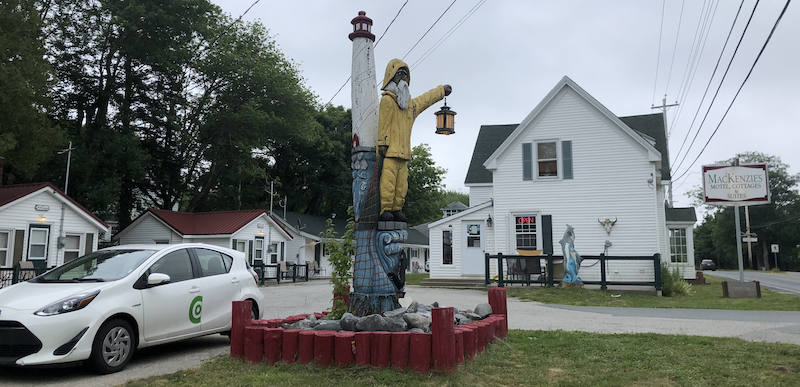
The event itself was going to take place on the southern end of Nova Scotia, 300 kilometers south of Halifax, along the coastline of Sherose Island, close to Barrington. Most of my previous marathons were big events, with thousands or tens of thousands of participants. The ‘Sea Me Run’ marathon was going to be much different: much less than 100 runners were registered for the full distance, and everything was organized by local volunteers. Including a delicious spaghetti dinner the evening before the race, served in the local gym. Nothing beats some good carbo loading amongst other athletes!
The start: small
Race day morning was foggy. Someone predicted a heat wave, but who knows what that would mean in Nova Scotia terms – for me, that weather seemed perfect for running (not so much for sight-seeing): 16ºC, no wind, and thick fog. Those running pictures were going to be amazing!
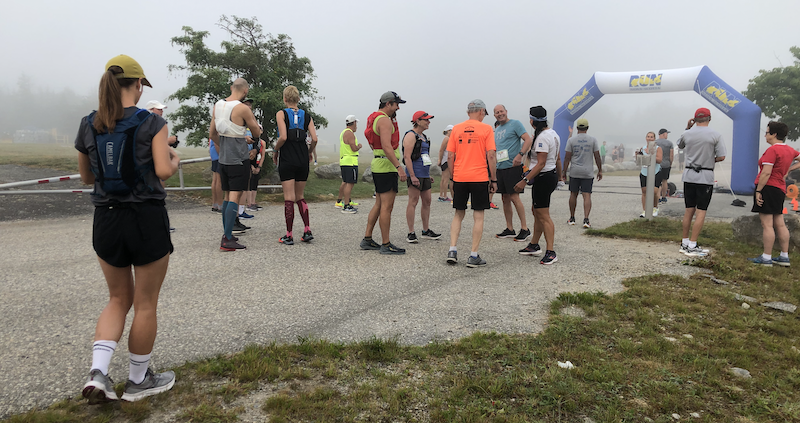
We only had 10 minutes to spare when we arrived at the venue. The run was going to start at 7am, and the tension was high — this was Tara’s first ever Marathon start, and we planned to spend most of the run together and watch each other’s pace. A quick selfie, double-checking the shoelaces and not much time was left before the gun; quite different from those huge mega-running-events where you wait sometimes hours before you even get going! Today was different. Some Ottawa weekly running groups are bigger than the field of runners of this entire marathon event.
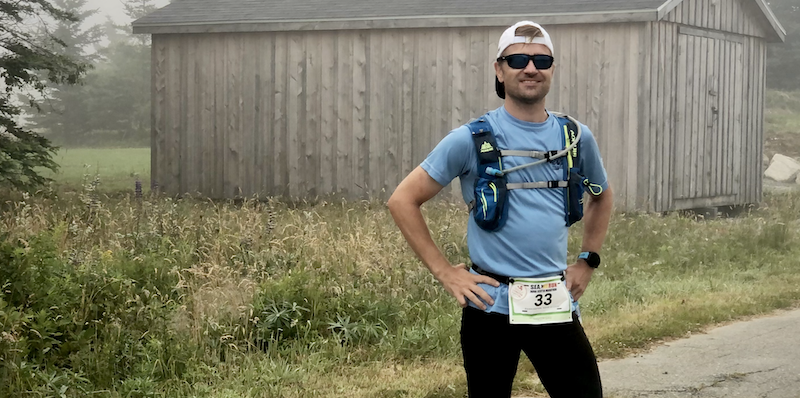
Tara and I started at the end of the small pack. We quickly settled at a comfortable pace of 5:30 minutes per kilometer. It didn’t take long until the group of athletes stretched out enough that it almost felt like you were on a training run on your own. The fog made for a somewhat mystic atmosphere, the temperature was just perfect, and we very much enjoyed running the small, calm streets, along local businesses that were still closed at that time. There was no need to close off the streets, that early on a Sunday in this part of the country. And yet, the occasional elderly couple found its way outside their old residence, enjoying their first morning coffee cheering the runners passing by their property as if this was the first eventful morning in the longest time.

It wouldn’t take long until we passed the first water station; every around 3 kilometers there was one, which is quite impressive for an event of that small size. I’ve gotten used to bring my own nutrition, though, and kept sipping on my 1.5-liter water-Tailwind-mix on my back while smiling and waving to the cheerful volunteers.
First 10k and mid-run: Finding a rhythm
The first hour went by quickly, and neither of us felt any signs of fatigue. Once in a while we passed another runner, but at this point we hardly saw anyone anymore. The fog was still thick and the only sign of any ocean close by was the salty air itself. The vegetation reminded more of a forest than a coastline, with plenty of bushes and trees on both sides of the smooth and calm asphalt road we followed around the peninsula. With not too much to see and no other human beings around it was great to have a running partner next to you to chat and share the otherwise potentially somewhat lonely experience with.
Running at a pace that is much below your fastest marathon can feel surprisingly relaxing. I would sometimes jog ahead or stay behind to take pictures, and once it got warmer, we’d shortly stop at water stations to take advantage of the soaked sponges to stay cool, before picking up the pace again.

Both of us felt confident and strong for the longest time during this run. The halfway point was way behind us, and even when we passed the 30km mark and the sun was starting to win against the fog, our legs kept carrying us at an unchanged pace back towards Barrington. It was mid-morning now and we’d been running for more than two hours while the traffic had picked up around us quite a bit. Our mood stayed up, though, and all that was left was a 10k run.
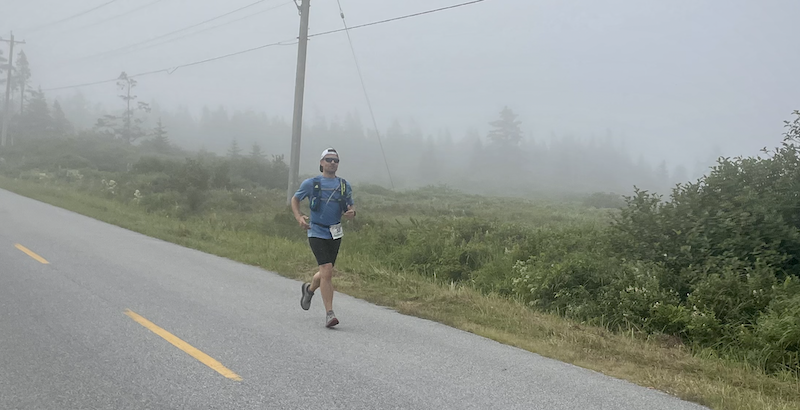
To the finish line
At kilometer 35 I still felt so fresh that I seriously thought about speeding up and push the final kilometers at a faster pace. I checked in with Tara, who now was struggling a bit but given that this was her first marathon looked still surprisingly strong and was she seemed confident enough to keep on going on her own. I couldn’t help it but picked up my stride and pace to around 4:40 minutes per kilometer. The first time ever that I was able to do that; usually, this is a turning point in the race into the opposite direction. Kilometer 35 often is where runners hit what they call the wall, suddenly slowing down significantly and struggling both physically and mentally. This was the reality in most of my prior marathons but not today. I may as well take advantage of it, I thought, and kept going; still expecting that maybe just 10 minutes later I’d pay for it, but I never did.
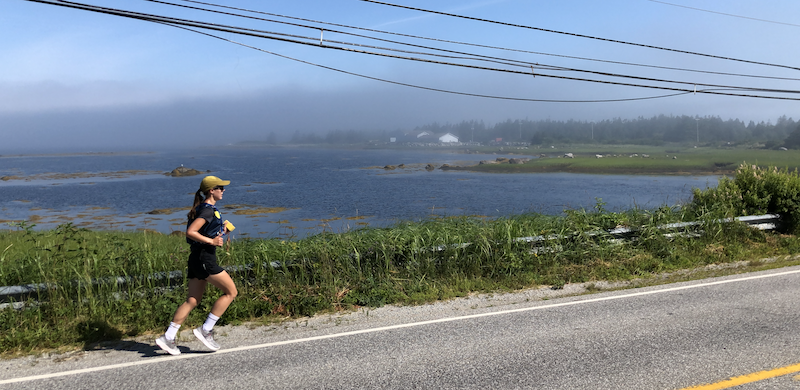
The final mile was hard, for sure, but crossing that finish line after a 7km relatively fast pace felt incredibly good. Marathon #9 was done, the third one this year. Full of endorphins I sat down in the grass, refueling, proudly wearing that really creative medal, and waiting for Tara. It didn’t take too long and I saw her crossing the finish line – what an experience to share with your partner!
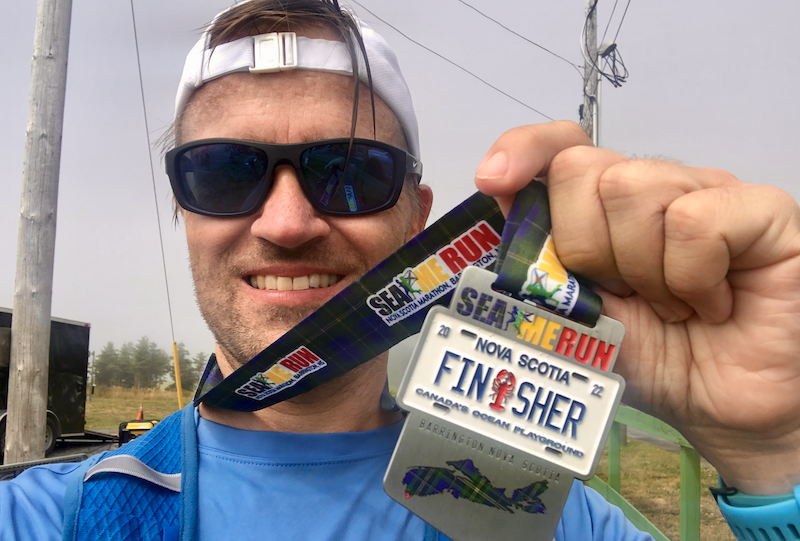
And believe it or not, the best was yet to come: After taking a quick shuttle back to the starting line (this was a loop, but the finish was a couple kilometers out of the way), we enjoyed the best post-race food you can imagine. All-you-can-eat fresh seafood and fish chowder, self-baked cake and cookies served by the local volunteers in the gym where we had our pasta meal just the day before. Taking in a good mix of natural protein, salt, and carbs while talking to fellow runners about their own race is just the perfect way to end a long morning activity.
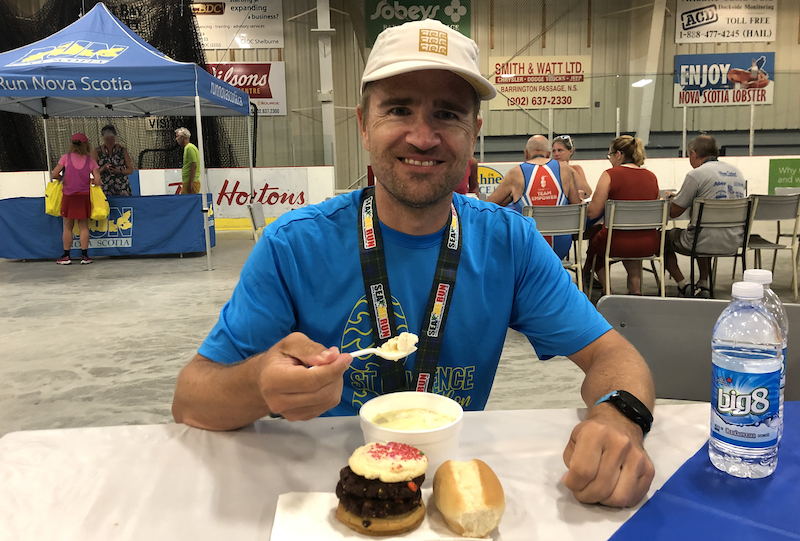
Aftermath
- Running a marathon in an easy pace can really pay out at the end.
- Marathon running experience over multiple year can offset a bumpy training season.
- Hats off to the organizers of such a lovely local event. Definitely one of my favorite marathons I’ve done; and worth the travel.
- The value of that event is great – beautiful medal, lots of good local food, lovely volunteers and organizers, a nice shirt (not a functional fabric, though), and just a great place overall.
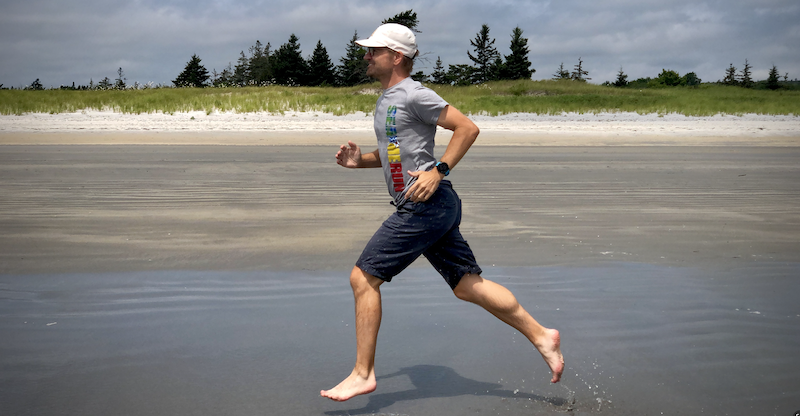
Stats
Total distance: 42.2km
Total time: 3:48:04
Average pace: 5:23min/km
Average HR: 159bpm
Total elevation: 180m
Calories burned: 2800
Calories consumed: 700
Fluids consumed: 1500ml
SeaMeRun Nova Scotia Marathon Barrington, NS, Canada | |||
Overall rating | |||
 | 2022 |  | 70 |
 | Summer |  | 1 loop |
 | 7:00AM |  | Slightly rolling (160m) |
 | 16ºC |  | Asphalt |
Individual ratings* | |||
Spectators | Scenery & views | ||
On-course nutrition | Overall organization | ||
Medal design | Finisher shirt | ||
Timing and splits | Value | ||
What stood out Pasta party before and Fish Chowder post-race, both included with the registration. Super local, very cozy atmosphere. And running along the ocean is just special in itself, and that thick fog during the first two hours was pretty memorable, too. | |||
*Individual ratings: details see below
Note that those ratings are highly subjective and only based on the last time I personally ran that particular race. Some things like medal or finisher shirt design can highly fluctuate from year to year. Please feel free to leave a comment or contact me for any more details.
Spectators: How many spectators along the course? How much action and welcome mental distraction for runners, especially during the second half of the course was offered? Higher ratings for more spectators, action, music, etc.
On-course nutrition: Number of water stations and variety of nutrition offered.
Medal design: Important aspects for me: Does the medal to some extent resemble the location or the course? Does it show the distance and date of the event? Does it have a reasonable size and shape? How creative is the design? Does it look cheap?
Timing and splits: How many timing mats were on the course? Were there timing mats in key areas to prevent shortcuts and to provide timing splits?
Scenery/views: How much visual distraction and awe do you get as a runner along the course. Usually one-loop or point-to-point races provide more variety than multi-loop courses. I value natural scenery higher than industrial or suburban areas.
Overall organization: How well was the whole event organized; including communication before and after the event, available course information, expo, additional events, pre- and post-race announcers, start and finish line area design, etc.
Finisher shirt: Design of the shirt, the type of fabric, is it full of sponsors?
Value: What you get vs what you paid. Some races are super expensive and you don’t even get a shirt, others are reasonably priced and even include a pasta party the day before. High ratings either mean cheap entry or lots of goodies.

